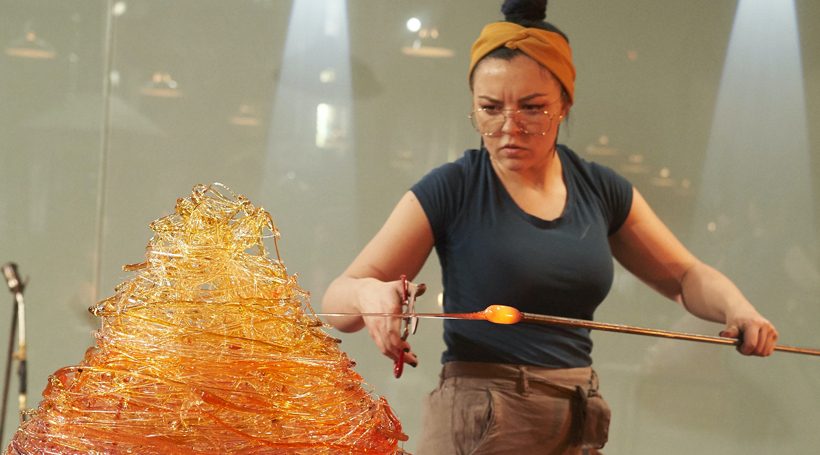Photo: David Leyes/marblemedia
Cat Burns’ mom just wanted her to get out of the house. After her high school graduation, the Swedesboro native says she had no idea what she wanted to do, and was “butting heads with my mom. Finally, she was like, ‘there’s a glassblowing place in Salem. You like setting things on fire. It’ll be a way to relax and figure out what you want to do.’ Well, it turned out to be what I wanted to do.”
In the last few years, the 30-year-old has become one of the most recognizable glass artists in America, thanks to both her undeniable skill and her fan-favorite role on the second season of Netflix’s smash reality competition show “Blown Away.”
Burns has traveled the world demonstrating and teaching glass-blowing, gone viral on TikTok, and earned a residency at the world’s foremost glass museum. But before all of that, she was learning to make scientific beakers at Salem Community College in Carneys Point.
“Salem’s known for scientific glassblowing – it’s very precise work,” Burns says. “I did that at first, and honestly despised it. But I had a crush on someone in the class, so I stuck with it, and tried to make my crush think I was cool.”
That relationship went nowhere, but Burns did ultimately fall in love with the act of glassblowing. She earned 2 associate degrees, one in Glass Fine Art and one in Glass Craft and Design. “But I knew I needed to find a way to learn outside the classroom,” she says. “This glass artist came to do a demo. He had a piece of scientific apparatus in his pocket and I said, ‘Is that a scientific apparatus in your pocket or are you just happy to see me?’ He was like, ‘You’re hired.’”
It wasn’t the first time Burns’ personality – her sarcastic wit and easy laugh – would help her career along. She became a freelance assistant to glass artists in Philadelphia, bouncing from studio to studio, making friends and learning, fast. “You learn these complicated skills that other artists are really adept at, because you’re the one there helping them,” she says. “And if you’re scared to do something, you just pretend you already know how to do it.”
Burns eventually headed to New York state, home to the renowned Corning Museum of Glass, and “moved into the moldiest, grossest camper, along some train tracks.” She taught classes for tourists, helping them create blown glass ornaments, and took a job as a technician, learning to break down and rebuild “glory holes” – the 1,000-degree furnaces used to heat glass.
Before long, she was handed an incredible opportunity. The museum had partnered with a cruise line, and Burns was among a group of artists hired as entertainment for the ship’s passengers. “Our job every day was to go snorkeling or hike a mountain, and whatever we saw that inspired us, we’d make,” she says. “I was on the trans-Pacific line, so I’d spend a lot of time in Alaska, then we’d go from Hawaii to Tahiti to Bora Bora and New Zealand.”
Burns says she would’ve been content to do that job forever, but the partnership between the cruise line and museum ended. “I was pretty lost,” she says. “I had this beautiful job, this dream job, and then it just didn’t exist anymore.”
Shortly after she got back onto dry land, in 2019, a family tragedy brought Burns back to South Jersey. “My grandfather died, and my family needed me,” she says. “I moved in with my grandmother and started working as a technician at Salem. It was like things had come full circle.”
Burns, like all the other glass artists she knew, had watched the first season of “Blown Away.” When applications opened for the second season, “I thought, well, I’m not doing anything else, I might as well apply for this,” she says.
She assumed her chances of making it on the show were slim, and admits she didn’t exactly take the application process seriously at first. “I got wine drunk with my mom and we sort of haphazardly wrote an application,” she says. “Within an hour they wrote back and said, ‘send us a video.’”
Within a few days, the field of aspiring contestants was narrowed from more than 500 to 100, then to 20 hopefuls, and finally to the 10 contestants chosen for the show. Burns was the youngest and least experienced artist chosen.
The show was filmed just outside of Toronto, Canada, over the course of a few months in early 2020 – just as the pandemic was taking off in North America.
“I traveled there on Chinese New Year, the day everyone was traveling,” she recalls. “Within a week, I was the sickest I’ve ever been in my whole life. I thought I had the flu or strep or something, and was almost like, ‘I can’t do this, take me to the hospital.’ The first 3 episodes they managed to not catch me coughing the whole time, but I was basically stoned on medication and don’t really remember filming them.”
What she does remember is the piece she made for the series – an intricate, personal piece called “Windows of Truth.” The contestants were challenged to create a piece of glass art that was a self-reflection, and Burns’ piece represented the fact that her eyesight is slowly getting worse.
“I have had really horrible vision my whole life,” she says. “I think for everyone else maybe it’s this shocking thing, but I’ve come to terms with it. My mom went legally blind by 40. The list of things wrong with my eyes is really weird. I have cataracts, I have super nearsightedness and overly enlarged pupils which creates basically astigmatism. My right eye is the really bad one. Everything looks like a funhouse mirror, and all the colors…I can’t see color the same way anymore, it’s all just fuzzy.”
Burns takes it in stride – she’s optimistic that medical research will progress quickly enough to eventually solve her eye problems, and in the meantime she embraces her vision’s impact on her work. “There are lots of things in glass you need really good vision for,” she says. “People say bubbles in glass are imperfections and need to come out. Well, all my work has bubbles because I just can’t see them. So my work kind of is about the imperfections.”
Her first piece kept her in the competition – an outcome she didn’t expect.
“The reason I made that fancier piece was because I was like well, I’m going out on the first episode, I at least want to make something other glassblowers won’t make fun of,” she says. Instead, Burns made it through to the very end, finishing the season as runner-up. In the final challenge, she created an installation centered around depression and mental health.

Photo: Netflix
“I’m getting messages from people telling me about their experiences with mental health. People have told me they were suicidal and seeing this made them look for help. I’m tearing up now, but there are so many tiny moments that can save you.”
“The craziest part is I’ve been trying to make work like that for the last 5 years,” she says. “The minute you talk about mental health with galleries, people are like, ‘why would we work with someone who might flake or have a bad day?’ They come back and say, ‘that’s not really our style.’ I have an entire binder of rejection letters that was me trying to make that work because I thought it would resonate with people. It was dumbfounding that Blown Away and Netflix – who have this crazy giant international stage – were like, ‘let’s talk about it.’”
And Burns was right: it did resonate. “I’m getting messages from people telling me about their experiences with mental health. People have told me they were suicidal and seeing this made them look for help. I’m tearing up now, but there are so many tiny moments that can save you.”
Today Burns is back in Corning, blowing glass almost every day and trying to embrace her newfound fame, and the demand for her work that’s come along with it.
“I had my website running when the season launched, and after 2 days I had to take it offline, because I had over a month’s worth of work in those 2 days,” she says. “I as one human cannot physically keep up with all of it, but that’s an awesome problem to have.”














